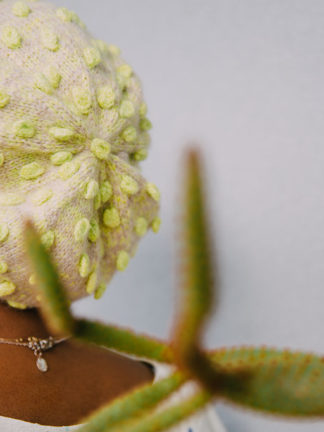3 hour class: Knotted Steek
The knotted steek is an unusual approach to steeking that is ideal for maintaining the stretchiness of your knitted fabric in a way that many steeks do not (because they rely on the use of crochet, sewing or ribbon to secure the stitches – these have much less stretch than most knitted fabric). Though it takes some time, the knotted steek results in a very smooth and not at all bulky finish that does not need to be used along the entire edge. This allows for greater flexibility and options in where you use a steek, which creates interesting design possibilities. It can also be used to build in an attractive fringed edge to shawls and scarves knitted in the round. It is the steek Anna uses in many of her patterns, including the Shantay Cardigan, Ess Shawl and Ruperto Scarf from Marlisle: A New Direction in Knitting as well as the Kermis Cardigan.
Suitable for stranded colourwork knitters of all levels who wish to expand their knowledge of steeks or those who wish to try steeking for the first time.
MINIMUM SKILL LEVEL
Intermediate/advanced beginner
EXISTING KNOWLEDGE/EXPERIENCE REQUIRED
– Experience of working stranded colourwork.
– You must be confident working small circumferences in the round in the manner of your choosing (for example using DPNs or the magic-loop method).
SKILLS COVERED
– understanding the function and application of steeks
– casting on and off for a knotted steek
– establishing a steek zone
– using steek edge stitches
– securing stitches for safety
– cutting through stitches
STUDENTS TO BRING
– pencil
– small, sharp scissors
– 4ply/fingering yarn in 2 contrasting, but harmonious colours. At least 25gr of each.
Go for 100% wool, ideally not super wash treated – you want something a little ‘sticky’ and forgiving for easier steeking and stranded colourwork.
– 3mm needles suitable for working small circumferences in the round (depending on personal preference and existing knowledge – aka it’s not a good time to try magic-loop for the first time!) or whatever needle size needed to achieve a good stranded colourwork gauge). Students can bring a range of sizes from 2.25mm to 4mm, as they may wish to adjust during class, while we are together.
HOST NOTES
MAXIMUM CLASS SIZE
12
VENUE TO PROVIDE
– quiet space for teaching
– chairs
– tables
– light
– refreshments
– possible use of white/blackboard or flipchart – a big piece of paper of some sort will do.




